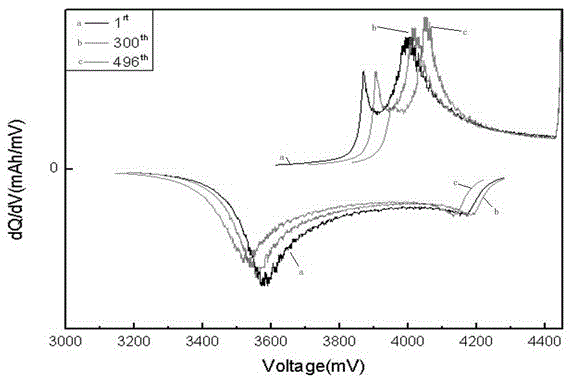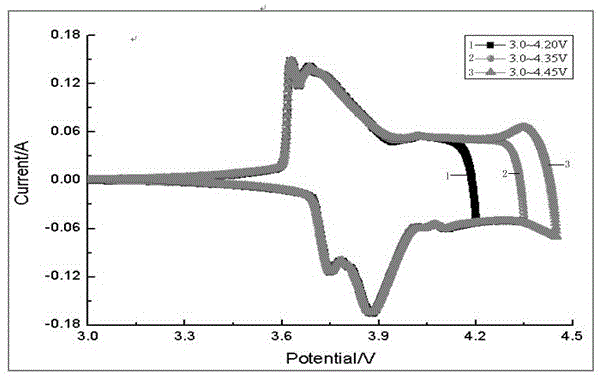High voltage electrolyte and lithium ion battery using the electrolyte
An electrolyte and high-voltage technology, applied in secondary batteries, circuits, electrical components, etc., can solve problems such as side reactions, achieve the effects of reducing decomposition, improving high-temperature performance, and inhibiting the dissolution of metal ions
- Summary
- Abstract
- Description
- Claims
- Application Information
AI Technical Summary
Problems solved by technology
Method used
Image
Examples
Embodiment 1
[0042] 1. For the preparation method of the high-voltage lithium-ion battery in this embodiment, the coating surface density is determined according to the capacity design of the battery (454261PL: 1640mAh) and the capacity of the positive and negative electrode materials. The positive electrode active material was purchased from Hunan Shanshan high-voltage lithium cobalt oxide material; the negative electrode active material was purchased from Jiangxi Zichen Technology. The positive electrode preparation steps, negative electrode preparation steps, electrolyte preparation steps, diaphragm preparation steps and battery assembly steps are described as follows;
[0043] The preparation step of the positive electrode is: mix the high-voltage positive electrode active material lithium cobaltate, conductive carbon black and binder polyvinylidene fluoride at a mass ratio of 96.8:2.0:1.2, and disperse them in N-methyl-2-pyrrolidone , to obtain the positive electrode slurry, the posit...
Embodiment 2~10
[0056] Examples 2-10 and Comparative Examples 1-4 are the same as Example 1 except that the composition of solvent in the electrolyte, the composition and content of additives (based on the total weight of the electrolyte) are added as shown in Table 1. Table 1 shows the content of each component of the electrolyte additive and the battery performance test results. In the table, PP is propyl propionate, GBL is butyrolactone, EP is ethyl propionate, DTD is vinyl sulfate, 1,3-PS is 1,3-propane sultone, SN is succinonitrile; A 1 is fumaric acid nitrile (n 1 =n 2 =0,C 4 h 2 N 2 ),A 2 is 3-hexenedinitrile (n 1 =n 2 =1,C 6 h 6 N 2 ).
[0057]
Embodiment 7
[0058] Embodiment 7 and embodiment 9 compare as can be seen with comparative example 2 and comparative example 4, do not contain 3-hexenedinitrile (C 6 h 6 N 2 ), the capacity retention rate of the 500th cycle of normal temperature cycle dropped to about 60%. High temperature storage (storage at 85°C for 4h) thickness expansion rate is much higher than that of the examples, and the capacity retention rate and recovery rate are both low, indicating that the positive electrode of the battery cannot be better protected during high temperature storage at 4.45V full charge state, resulting in electrode failure. Produce gas by side reaction with electrolyte.
[0059] The capacity retention rate of the 500th cycle of Example 7 and Example 9 is above 80%. The capacity voltage differential curves of Example 7 with different cycle numbers (the first cycle, the 300th cycle, and the 496th cycle) are shown in figure 1 . The cyclic voltammetry test result of embodiment 9 different volt...
PUM
| Property | Measurement | Unit |
|---|---|---|
| thickness | aaaaa | aaaaa |
Abstract
Description
Claims
Application Information
 Login to View More
Login to View More - R&D
- Intellectual Property
- Life Sciences
- Materials
- Tech Scout
- Unparalleled Data Quality
- Higher Quality Content
- 60% Fewer Hallucinations
Browse by: Latest US Patents, China's latest patents, Technical Efficacy Thesaurus, Application Domain, Technology Topic, Popular Technical Reports.
© 2025 PatSnap. All rights reserved.Legal|Privacy policy|Modern Slavery Act Transparency Statement|Sitemap|About US| Contact US: help@patsnap.com



